MMBB08: Activity Based Costing Report for UAE Trekker LLC
VerifiedAdded on 2022/08/12
|11
|2809
|19
Report
AI Summary
This report analyzes the implementation of Activity Based Costing (ABC) at UAE Trekker LLC, a company producing travel backpacks. The report begins with an executive summary, followed by a detailed discussion of the calculation of cost per unit using both traditional and ABC methods. It explains the reasons for changes in cost when switching from traditional absorption costing to ABC, and the potential cost management implications. The report further explores the effects of ABC on pricing and product profitability, as well as steps to take and pitfalls to avoid when introducing ABC into a business. The study highlights the benefits of ABC in providing more accurate cost information, leading to improved decision-making regarding pricing, resource allocation, and overall profitability. The report also examines the risks and difficulties related to the ABC system and the steps towards eliminating such risks. The report concludes with a summary of findings and recommendations for UAE Trekker LLC, emphasizing the importance of ABC for effective cost management and strategic decision-making. The report includes a table of contents, references, and appendices.
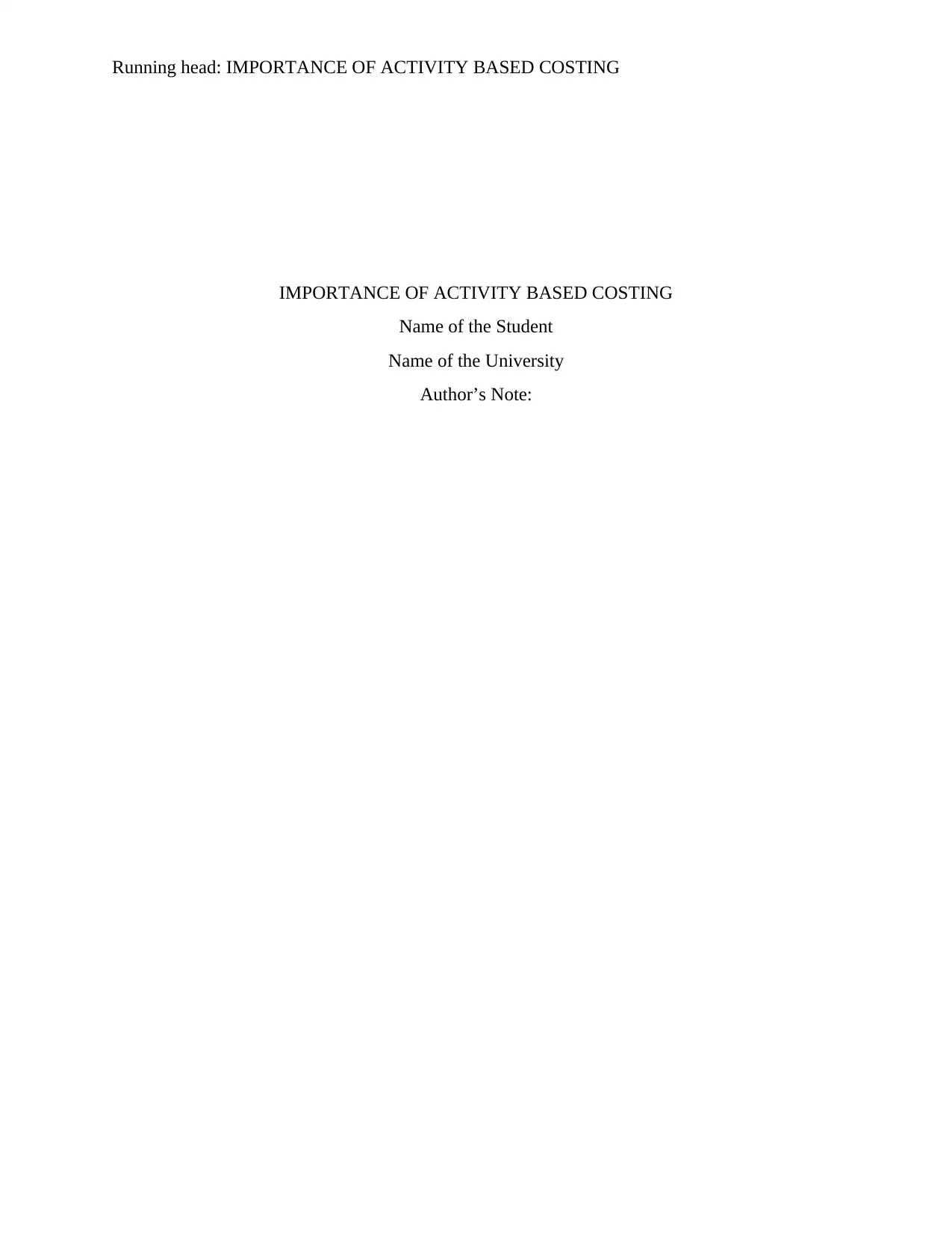
Running head: IMPORTANCE OF ACTIVITY BASED COSTING
IMPORTANCE OF ACTIVITY BASED COSTING
Name of the Student
Name of the University
Author’s Note:
IMPORTANCE OF ACTIVITY BASED COSTING
Name of the Student
Name of the University
Author’s Note:
Paraphrase This Document
Need a fresh take? Get an instant paraphrase of this document with our AI Paraphraser
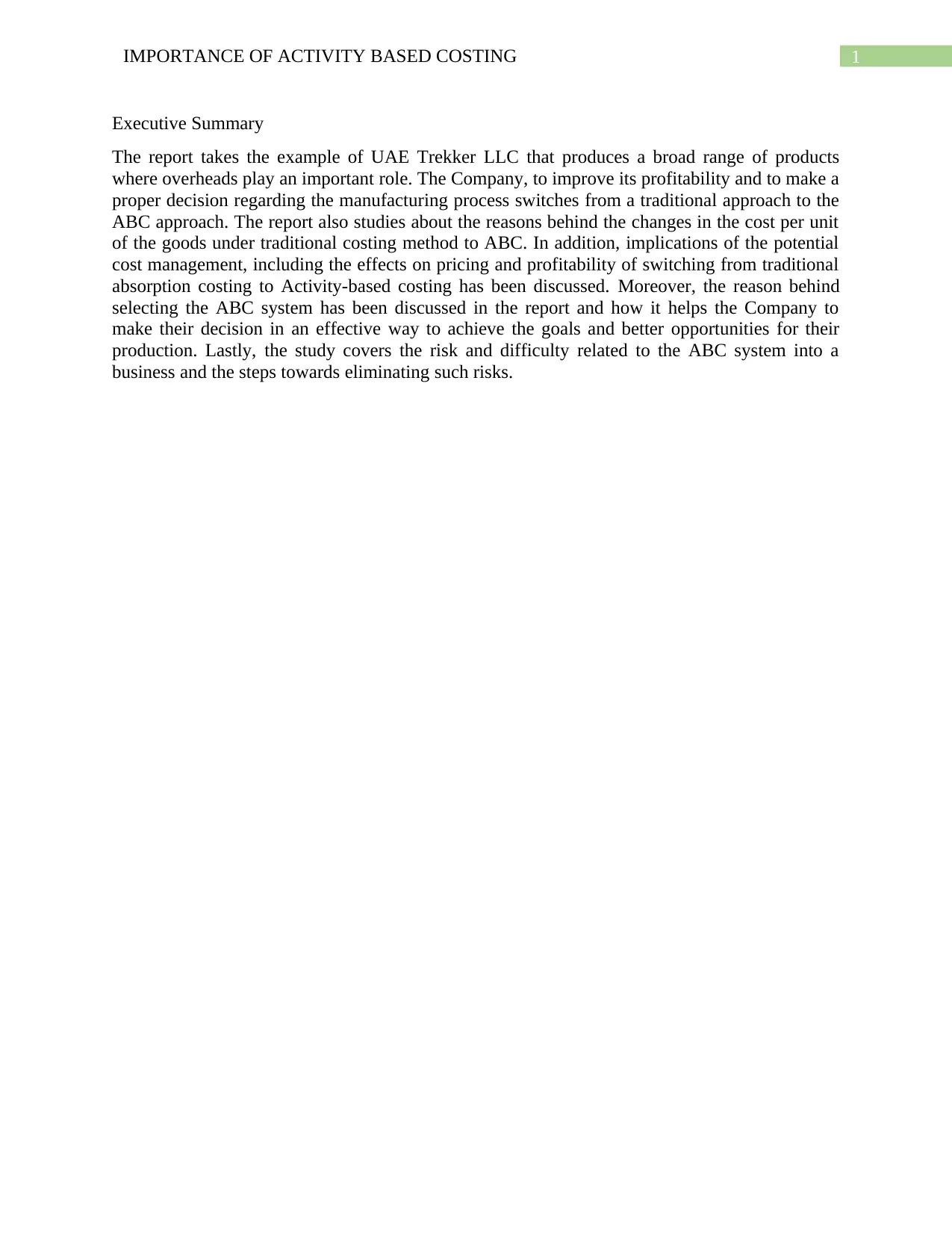
1IMPORTANCE OF ACTIVITY BASED COSTING
Executive Summary
The report takes the example of UAE Trekker LLC that produces a broad range of products
where overheads play an important role. The Company, to improve its profitability and to make a
proper decision regarding the manufacturing process switches from a traditional approach to the
ABC approach. The report also studies about the reasons behind the changes in the cost per unit
of the goods under traditional costing method to ABC. In addition, implications of the potential
cost management, including the effects on pricing and profitability of switching from traditional
absorption costing to Activity-based costing has been discussed. Moreover, the reason behind
selecting the ABC system has been discussed in the report and how it helps the Company to
make their decision in an effective way to achieve the goals and better opportunities for their
production. Lastly, the study covers the risk and difficulty related to the ABC system into a
business and the steps towards eliminating such risks.
Executive Summary
The report takes the example of UAE Trekker LLC that produces a broad range of products
where overheads play an important role. The Company, to improve its profitability and to make a
proper decision regarding the manufacturing process switches from a traditional approach to the
ABC approach. The report also studies about the reasons behind the changes in the cost per unit
of the goods under traditional costing method to ABC. In addition, implications of the potential
cost management, including the effects on pricing and profitability of switching from traditional
absorption costing to Activity-based costing has been discussed. Moreover, the reason behind
selecting the ABC system has been discussed in the report and how it helps the Company to
make their decision in an effective way to achieve the goals and better opportunities for their
production. Lastly, the study covers the risk and difficulty related to the ABC system into a
business and the steps towards eliminating such risks.

2IMPORTANCE OF ACTIVITY BASED COSTING
“I ………… declare that I am the sole author of this assignment and the work is a result of my
own investigations, except where otherwise stated. All references have been duly cited”.
“I ………… declare that I am the sole author of this assignment and the work is a result of my
own investigations, except where otherwise stated. All references have been duly cited”.
⊘ This is a preview!⊘
Do you want full access?
Subscribe today to unlock all pages.

Trusted by 1+ million students worldwide
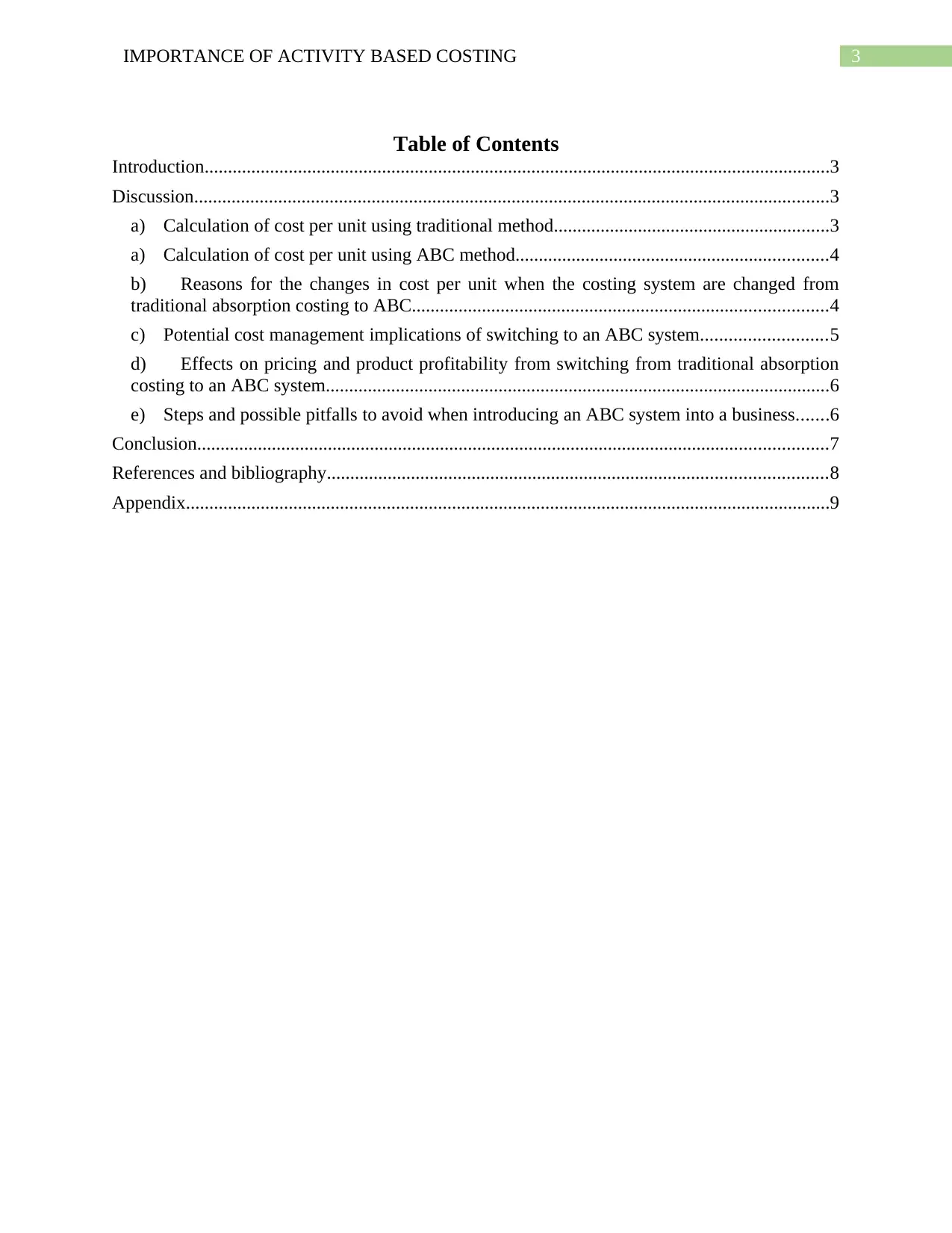
3IMPORTANCE OF ACTIVITY BASED COSTING
Table of Contents
Introduction......................................................................................................................................3
Discussion........................................................................................................................................3
a) Calculation of cost per unit using traditional method...........................................................3
a) Calculation of cost per unit using ABC method...................................................................4
b) Reasons for the changes in cost per unit when the costing system are changed from
traditional absorption costing to ABC.........................................................................................4
c) Potential cost management implications of switching to an ABC system...........................5
d) Effects on pricing and product profitability from switching from traditional absorption
costing to an ABC system............................................................................................................6
e) Steps and possible pitfalls to avoid when introducing an ABC system into a business.......6
Conclusion.......................................................................................................................................7
References and bibliography...........................................................................................................8
Appendix..........................................................................................................................................9
Table of Contents
Introduction......................................................................................................................................3
Discussion........................................................................................................................................3
a) Calculation of cost per unit using traditional method...........................................................3
a) Calculation of cost per unit using ABC method...................................................................4
b) Reasons for the changes in cost per unit when the costing system are changed from
traditional absorption costing to ABC.........................................................................................4
c) Potential cost management implications of switching to an ABC system...........................5
d) Effects on pricing and product profitability from switching from traditional absorption
costing to an ABC system............................................................................................................6
e) Steps and possible pitfalls to avoid when introducing an ABC system into a business.......6
Conclusion.......................................................................................................................................7
References and bibliography...........................................................................................................8
Appendix..........................................................................................................................................9
Paraphrase This Document
Need a fresh take? Get an instant paraphrase of this document with our AI Paraphraser
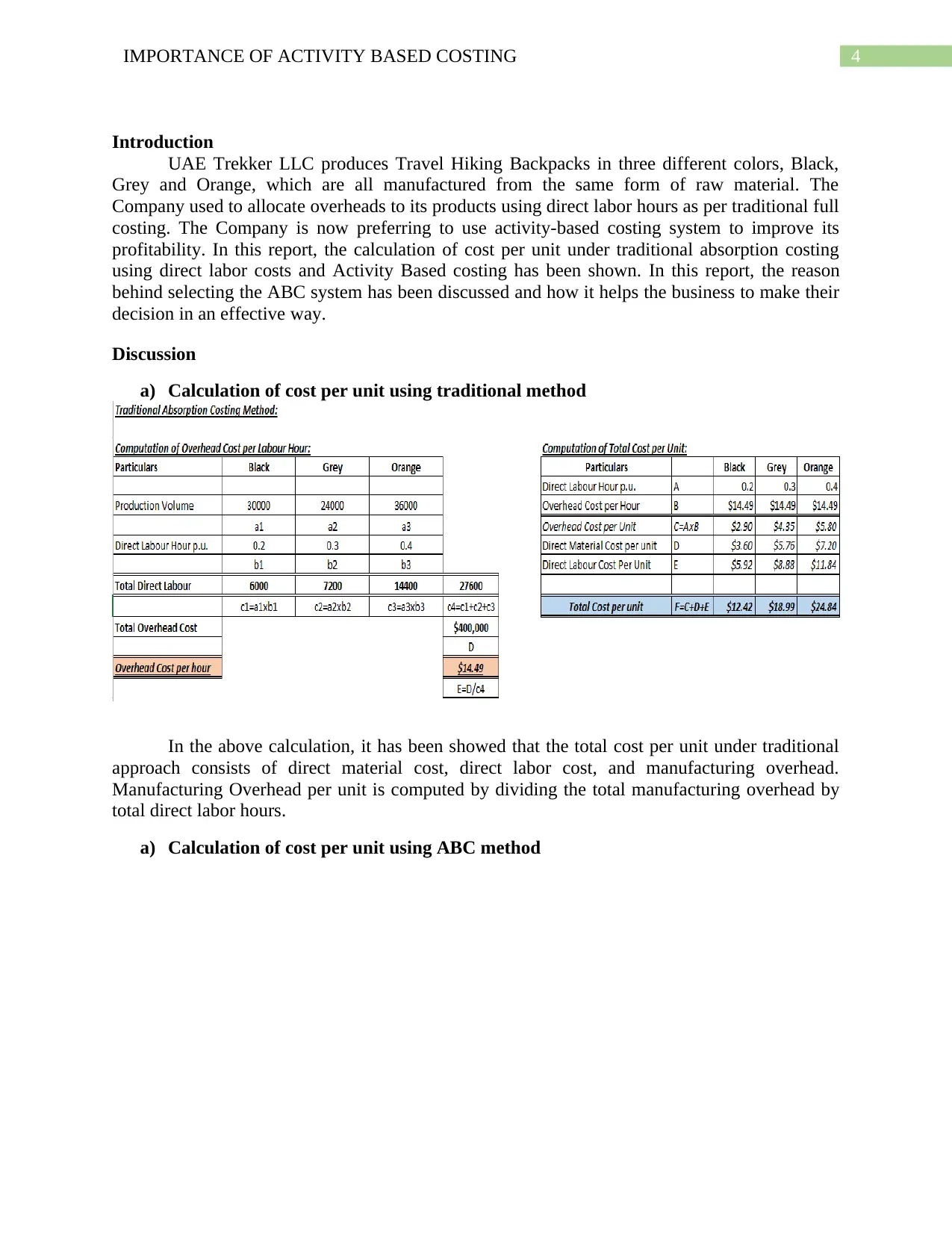
4IMPORTANCE OF ACTIVITY BASED COSTING
Introduction
UAE Trekker LLC produces Travel Hiking Backpacks in three different colors, Black,
Grey and Orange, which are all manufactured from the same form of raw material. The
Company used to allocate overheads to its products using direct labor hours as per traditional full
costing. The Company is now preferring to use activity-based costing system to improve its
profitability. In this report, the calculation of cost per unit under traditional absorption costing
using direct labor costs and Activity Based costing has been shown. In this report, the reason
behind selecting the ABC system has been discussed and how it helps the business to make their
decision in an effective way.
Discussion
a) Calculation of cost per unit using traditional method
In the above calculation, it has been showed that the total cost per unit under traditional
approach consists of direct material cost, direct labor cost, and manufacturing overhead.
Manufacturing Overhead per unit is computed by dividing the total manufacturing overhead by
total direct labor hours.
a) Calculation of cost per unit using ABC method
Introduction
UAE Trekker LLC produces Travel Hiking Backpacks in three different colors, Black,
Grey and Orange, which are all manufactured from the same form of raw material. The
Company used to allocate overheads to its products using direct labor hours as per traditional full
costing. The Company is now preferring to use activity-based costing system to improve its
profitability. In this report, the calculation of cost per unit under traditional absorption costing
using direct labor costs and Activity Based costing has been shown. In this report, the reason
behind selecting the ABC system has been discussed and how it helps the business to make their
decision in an effective way.
Discussion
a) Calculation of cost per unit using traditional method
In the above calculation, it has been showed that the total cost per unit under traditional
approach consists of direct material cost, direct labor cost, and manufacturing overhead.
Manufacturing Overhead per unit is computed by dividing the total manufacturing overhead by
total direct labor hours.
a) Calculation of cost per unit using ABC method
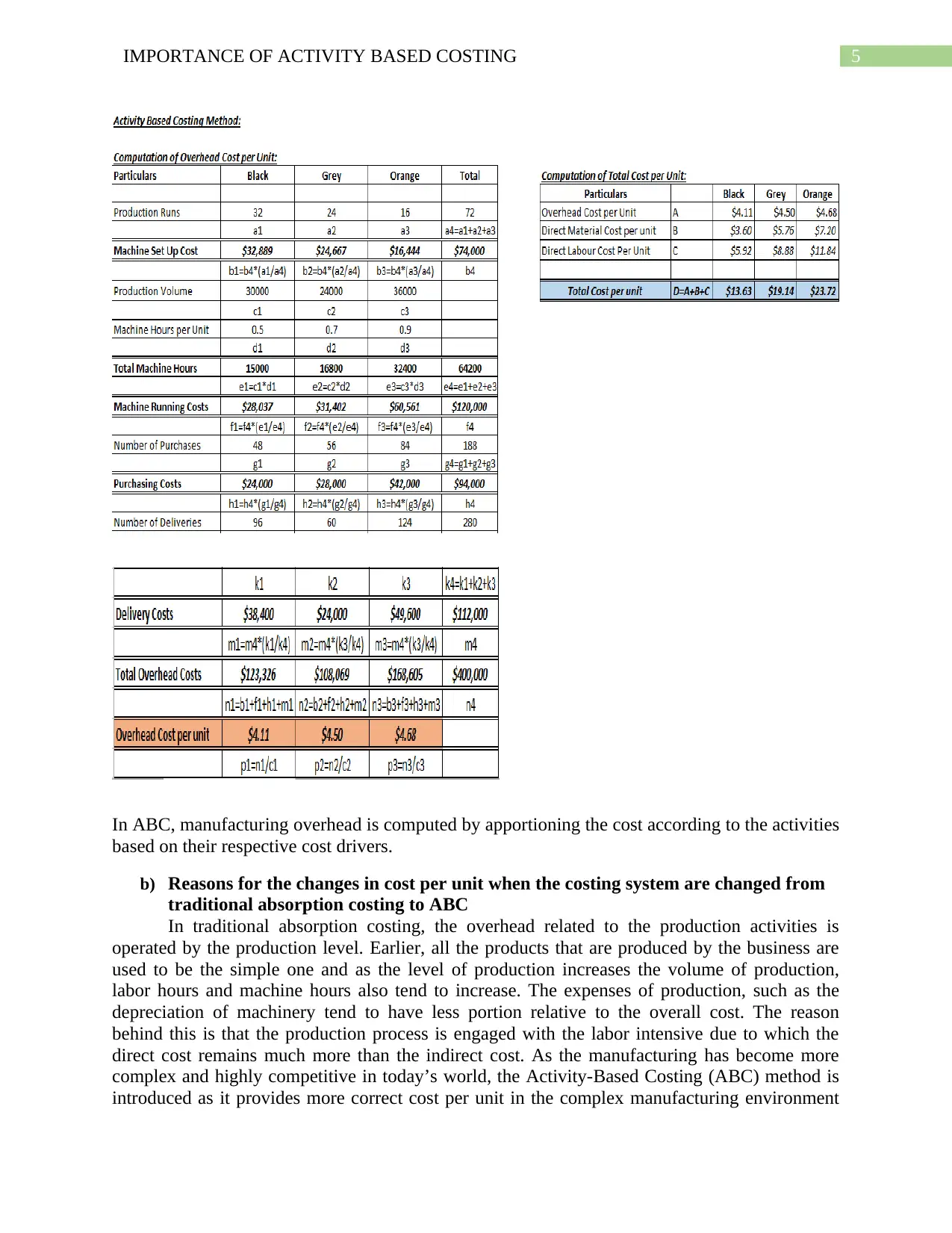
5IMPORTANCE OF ACTIVITY BASED COSTING
In ABC, manufacturing overhead is computed by apportioning the cost according to the activities
based on their respective cost drivers.
b) Reasons for the changes in cost per unit when the costing system are changed from
traditional absorption costing to ABC
In traditional absorption costing, the overhead related to the production activities is
operated by the production level. Earlier, all the products that are produced by the business are
used to be the simple one and as the level of production increases the volume of production,
labor hours and machine hours also tend to increase. The expenses of production, such as the
depreciation of machinery tend to have less portion relative to the overall cost. The reason
behind this is that the production process is engaged with the labor intensive due to which the
direct cost remains much more than the indirect cost. As the manufacturing has become more
complex and highly competitive in today’s world, the Activity-Based Costing (ABC) method is
introduced as it provides more correct cost per unit in the complex manufacturing environment
In ABC, manufacturing overhead is computed by apportioning the cost according to the activities
based on their respective cost drivers.
b) Reasons for the changes in cost per unit when the costing system are changed from
traditional absorption costing to ABC
In traditional absorption costing, the overhead related to the production activities is
operated by the production level. Earlier, all the products that are produced by the business are
used to be the simple one and as the level of production increases the volume of production,
labor hours and machine hours also tend to increase. The expenses of production, such as the
depreciation of machinery tend to have less portion relative to the overall cost. The reason
behind this is that the production process is engaged with the labor intensive due to which the
direct cost remains much more than the indirect cost. As the manufacturing has become more
complex and highly competitive in today’s world, the Activity-Based Costing (ABC) method is
introduced as it provides more correct cost per unit in the complex manufacturing environment
⊘ This is a preview!⊘
Do you want full access?
Subscribe today to unlock all pages.

Trusted by 1+ million students worldwide
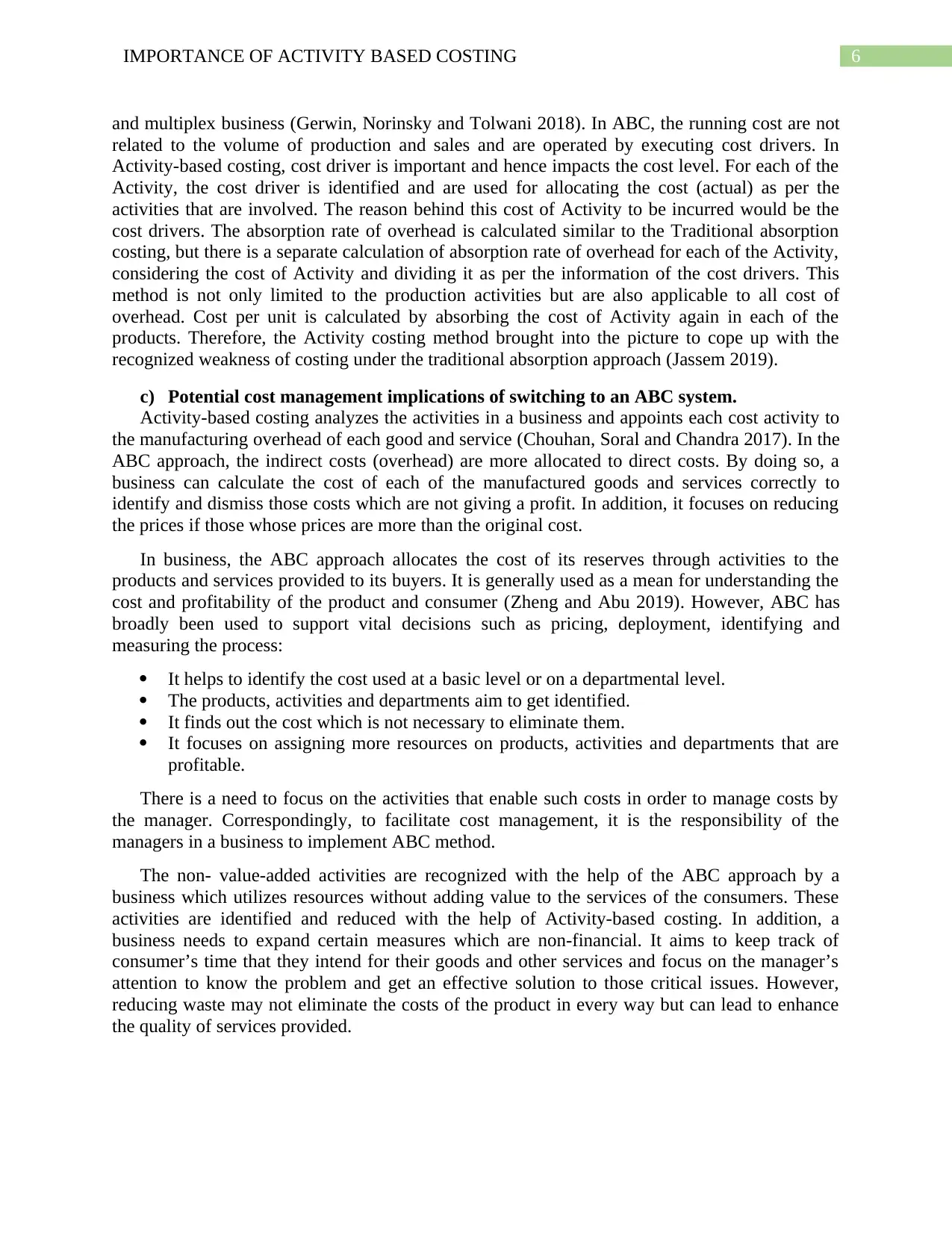
6IMPORTANCE OF ACTIVITY BASED COSTING
and multiplex business (Gerwin, Norinsky and Tolwani 2018). In ABC, the running cost are not
related to the volume of production and sales and are operated by executing cost drivers. In
Activity-based costing, cost driver is important and hence impacts the cost level. For each of the
Activity, the cost driver is identified and are used for allocating the cost (actual) as per the
activities that are involved. The reason behind this cost of Activity to be incurred would be the
cost drivers. The absorption rate of overhead is calculated similar to the Traditional absorption
costing, but there is a separate calculation of absorption rate of overhead for each of the Activity,
considering the cost of Activity and dividing it as per the information of the cost drivers. This
method is not only limited to the production activities but are also applicable to all cost of
overhead. Cost per unit is calculated by absorbing the cost of Activity again in each of the
products. Therefore, the Activity costing method brought into the picture to cope up with the
recognized weakness of costing under the traditional absorption approach (Jassem 2019).
c) Potential cost management implications of switching to an ABC system.
Activity-based costing analyzes the activities in a business and appoints each cost activity to
the manufacturing overhead of each good and service (Chouhan, Soral and Chandra 2017). In the
ABC approach, the indirect costs (overhead) are more allocated to direct costs. By doing so, a
business can calculate the cost of each of the manufactured goods and services correctly to
identify and dismiss those costs which are not giving a profit. In addition, it focuses on reducing
the prices if those whose prices are more than the original cost.
In business, the ABC approach allocates the cost of its reserves through activities to the
products and services provided to its buyers. It is generally used as a mean for understanding the
cost and profitability of the product and consumer (Zheng and Abu 2019). However, ABC has
broadly been used to support vital decisions such as pricing, deployment, identifying and
measuring the process:
It helps to identify the cost used at a basic level or on a departmental level.
The products, activities and departments aim to get identified.
It finds out the cost which is not necessary to eliminate them.
It focuses on assigning more resources on products, activities and departments that are
profitable.
There is a need to focus on the activities that enable such costs in order to manage costs by
the manager. Correspondingly, to facilitate cost management, it is the responsibility of the
managers in a business to implement ABC method.
The non- value-added activities are recognized with the help of the ABC approach by a
business which utilizes resources without adding value to the services of the consumers. These
activities are identified and reduced with the help of Activity-based costing. In addition, a
business needs to expand certain measures which are non-financial. It aims to keep track of
consumer’s time that they intend for their goods and other services and focus on the manager’s
attention to know the problem and get an effective solution to those critical issues. However,
reducing waste may not eliminate the costs of the product in every way but can lead to enhance
the quality of services provided.
and multiplex business (Gerwin, Norinsky and Tolwani 2018). In ABC, the running cost are not
related to the volume of production and sales and are operated by executing cost drivers. In
Activity-based costing, cost driver is important and hence impacts the cost level. For each of the
Activity, the cost driver is identified and are used for allocating the cost (actual) as per the
activities that are involved. The reason behind this cost of Activity to be incurred would be the
cost drivers. The absorption rate of overhead is calculated similar to the Traditional absorption
costing, but there is a separate calculation of absorption rate of overhead for each of the Activity,
considering the cost of Activity and dividing it as per the information of the cost drivers. This
method is not only limited to the production activities but are also applicable to all cost of
overhead. Cost per unit is calculated by absorbing the cost of Activity again in each of the
products. Therefore, the Activity costing method brought into the picture to cope up with the
recognized weakness of costing under the traditional absorption approach (Jassem 2019).
c) Potential cost management implications of switching to an ABC system.
Activity-based costing analyzes the activities in a business and appoints each cost activity to
the manufacturing overhead of each good and service (Chouhan, Soral and Chandra 2017). In the
ABC approach, the indirect costs (overhead) are more allocated to direct costs. By doing so, a
business can calculate the cost of each of the manufactured goods and services correctly to
identify and dismiss those costs which are not giving a profit. In addition, it focuses on reducing
the prices if those whose prices are more than the original cost.
In business, the ABC approach allocates the cost of its reserves through activities to the
products and services provided to its buyers. It is generally used as a mean for understanding the
cost and profitability of the product and consumer (Zheng and Abu 2019). However, ABC has
broadly been used to support vital decisions such as pricing, deployment, identifying and
measuring the process:
It helps to identify the cost used at a basic level or on a departmental level.
The products, activities and departments aim to get identified.
It finds out the cost which is not necessary to eliminate them.
It focuses on assigning more resources on products, activities and departments that are
profitable.
There is a need to focus on the activities that enable such costs in order to manage costs by
the manager. Correspondingly, to facilitate cost management, it is the responsibility of the
managers in a business to implement ABC method.
The non- value-added activities are recognized with the help of the ABC approach by a
business which utilizes resources without adding value to the services of the consumers. These
activities are identified and reduced with the help of Activity-based costing. In addition, a
business needs to expand certain measures which are non-financial. It aims to keep track of
consumer’s time that they intend for their goods and other services and focus on the manager’s
attention to know the problem and get an effective solution to those critical issues. However,
reducing waste may not eliminate the costs of the product in every way but can lead to enhance
the quality of services provided.
Paraphrase This Document
Need a fresh take? Get an instant paraphrase of this document with our AI Paraphraser
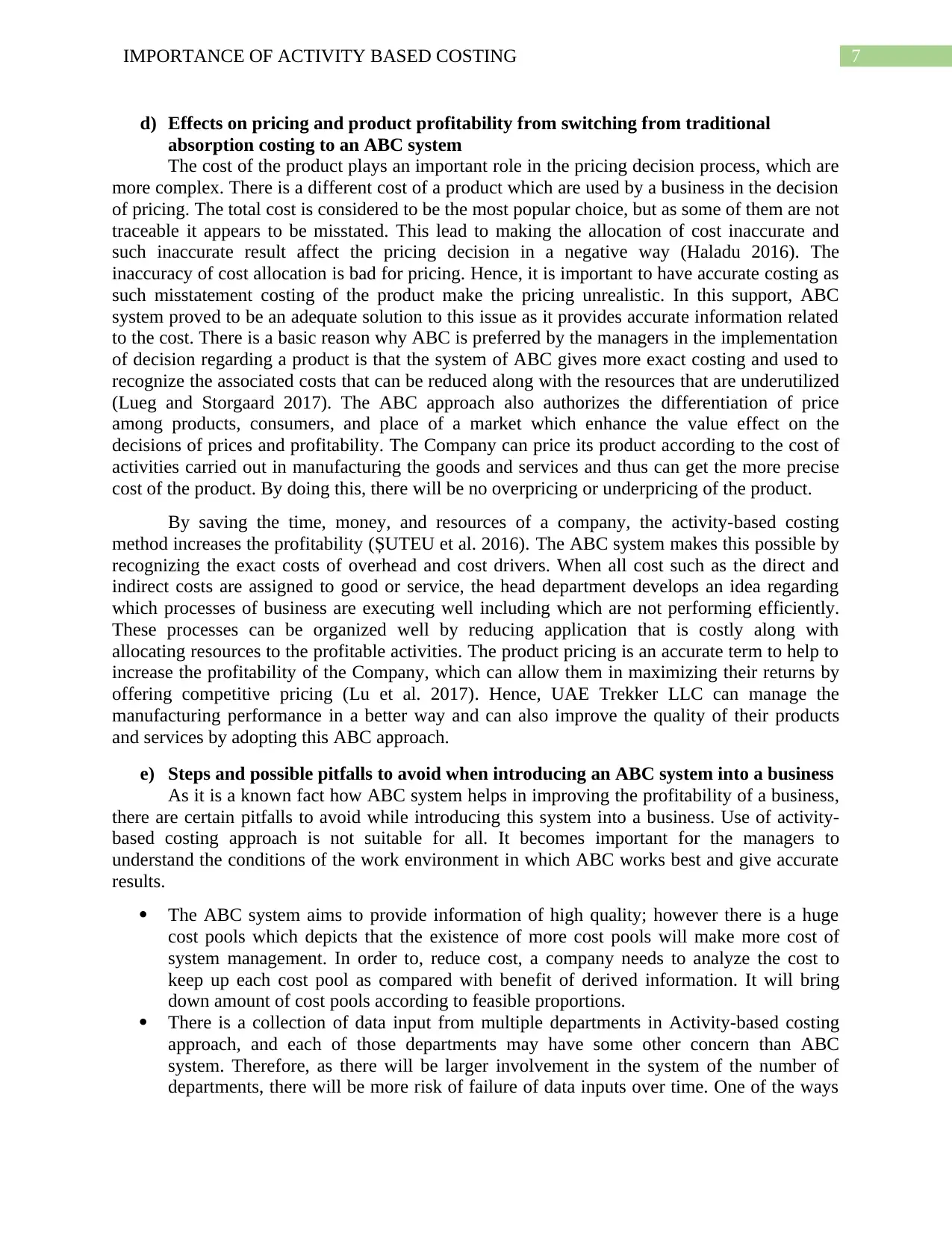
7IMPORTANCE OF ACTIVITY BASED COSTING
d) Effects on pricing and product profitability from switching from traditional
absorption costing to an ABC system
The cost of the product plays an important role in the pricing decision process, which are
more complex. There is a different cost of a product which are used by a business in the decision
of pricing. The total cost is considered to be the most popular choice, but as some of them are not
traceable it appears to be misstated. This lead to making the allocation of cost inaccurate and
such inaccurate result affect the pricing decision in a negative way (Haladu 2016). The
inaccuracy of cost allocation is bad for pricing. Hence, it is important to have accurate costing as
such misstatement costing of the product make the pricing unrealistic. In this support, ABC
system proved to be an adequate solution to this issue as it provides accurate information related
to the cost. There is a basic reason why ABC is preferred by the managers in the implementation
of decision regarding a product is that the system of ABC gives more exact costing and used to
recognize the associated costs that can be reduced along with the resources that are underutilized
(Lueg and Storgaard 2017). The ABC approach also authorizes the differentiation of price
among products, consumers, and place of a market which enhance the value effect on the
decisions of prices and profitability. The Company can price its product according to the cost of
activities carried out in manufacturing the goods and services and thus can get the more precise
cost of the product. By doing this, there will be no overpricing or underpricing of the product.
By saving the time, money, and resources of a company, the activity-based costing
method increases the profitability (ȘUTEU et al. 2016). The ABC system makes this possible by
recognizing the exact costs of overhead and cost drivers. When all cost such as the direct and
indirect costs are assigned to good or service, the head department develops an idea regarding
which processes of business are executing well including which are not performing efficiently.
These processes can be organized well by reducing application that is costly along with
allocating resources to the profitable activities. The product pricing is an accurate term to help to
increase the profitability of the Company, which can allow them in maximizing their returns by
offering competitive pricing (Lu et al. 2017). Hence, UAE Trekker LLC can manage the
manufacturing performance in a better way and can also improve the quality of their products
and services by adopting this ABC approach.
e) Steps and possible pitfalls to avoid when introducing an ABC system into a business
As it is a known fact how ABC system helps in improving the profitability of a business,
there are certain pitfalls to avoid while introducing this system into a business. Use of activity-
based costing approach is not suitable for all. It becomes important for the managers to
understand the conditions of the work environment in which ABC works best and give accurate
results.
The ABC system aims to provide information of high quality; however there is a huge
cost pools which depicts that the existence of more cost pools will make more cost of
system management. In order to, reduce cost, a company needs to analyze the cost to
keep up each cost pool as compared with benefit of derived information. It will bring
down amount of cost pools according to feasible proportions.
There is a collection of data input from multiple departments in Activity-based costing
approach, and each of those departments may have some other concern than ABC
system. Therefore, as there will be larger involvement in the system of the number of
departments, there will be more risk of failure of data inputs over time. One of the ways
d) Effects on pricing and product profitability from switching from traditional
absorption costing to an ABC system
The cost of the product plays an important role in the pricing decision process, which are
more complex. There is a different cost of a product which are used by a business in the decision
of pricing. The total cost is considered to be the most popular choice, but as some of them are not
traceable it appears to be misstated. This lead to making the allocation of cost inaccurate and
such inaccurate result affect the pricing decision in a negative way (Haladu 2016). The
inaccuracy of cost allocation is bad for pricing. Hence, it is important to have accurate costing as
such misstatement costing of the product make the pricing unrealistic. In this support, ABC
system proved to be an adequate solution to this issue as it provides accurate information related
to the cost. There is a basic reason why ABC is preferred by the managers in the implementation
of decision regarding a product is that the system of ABC gives more exact costing and used to
recognize the associated costs that can be reduced along with the resources that are underutilized
(Lueg and Storgaard 2017). The ABC approach also authorizes the differentiation of price
among products, consumers, and place of a market which enhance the value effect on the
decisions of prices and profitability. The Company can price its product according to the cost of
activities carried out in manufacturing the goods and services and thus can get the more precise
cost of the product. By doing this, there will be no overpricing or underpricing of the product.
By saving the time, money, and resources of a company, the activity-based costing
method increases the profitability (ȘUTEU et al. 2016). The ABC system makes this possible by
recognizing the exact costs of overhead and cost drivers. When all cost such as the direct and
indirect costs are assigned to good or service, the head department develops an idea regarding
which processes of business are executing well including which are not performing efficiently.
These processes can be organized well by reducing application that is costly along with
allocating resources to the profitable activities. The product pricing is an accurate term to help to
increase the profitability of the Company, which can allow them in maximizing their returns by
offering competitive pricing (Lu et al. 2017). Hence, UAE Trekker LLC can manage the
manufacturing performance in a better way and can also improve the quality of their products
and services by adopting this ABC approach.
e) Steps and possible pitfalls to avoid when introducing an ABC system into a business
As it is a known fact how ABC system helps in improving the profitability of a business,
there are certain pitfalls to avoid while introducing this system into a business. Use of activity-
based costing approach is not suitable for all. It becomes important for the managers to
understand the conditions of the work environment in which ABC works best and give accurate
results.
The ABC system aims to provide information of high quality; however there is a huge
cost pools which depicts that the existence of more cost pools will make more cost of
system management. In order to, reduce cost, a company needs to analyze the cost to
keep up each cost pool as compared with benefit of derived information. It will bring
down amount of cost pools according to feasible proportions.
There is a collection of data input from multiple departments in Activity-based costing
approach, and each of those departments may have some other concern than ABC
system. Therefore, as there will be larger involvement in the system of the number of
departments, there will be more risk of failure of data inputs over time. One of the ways
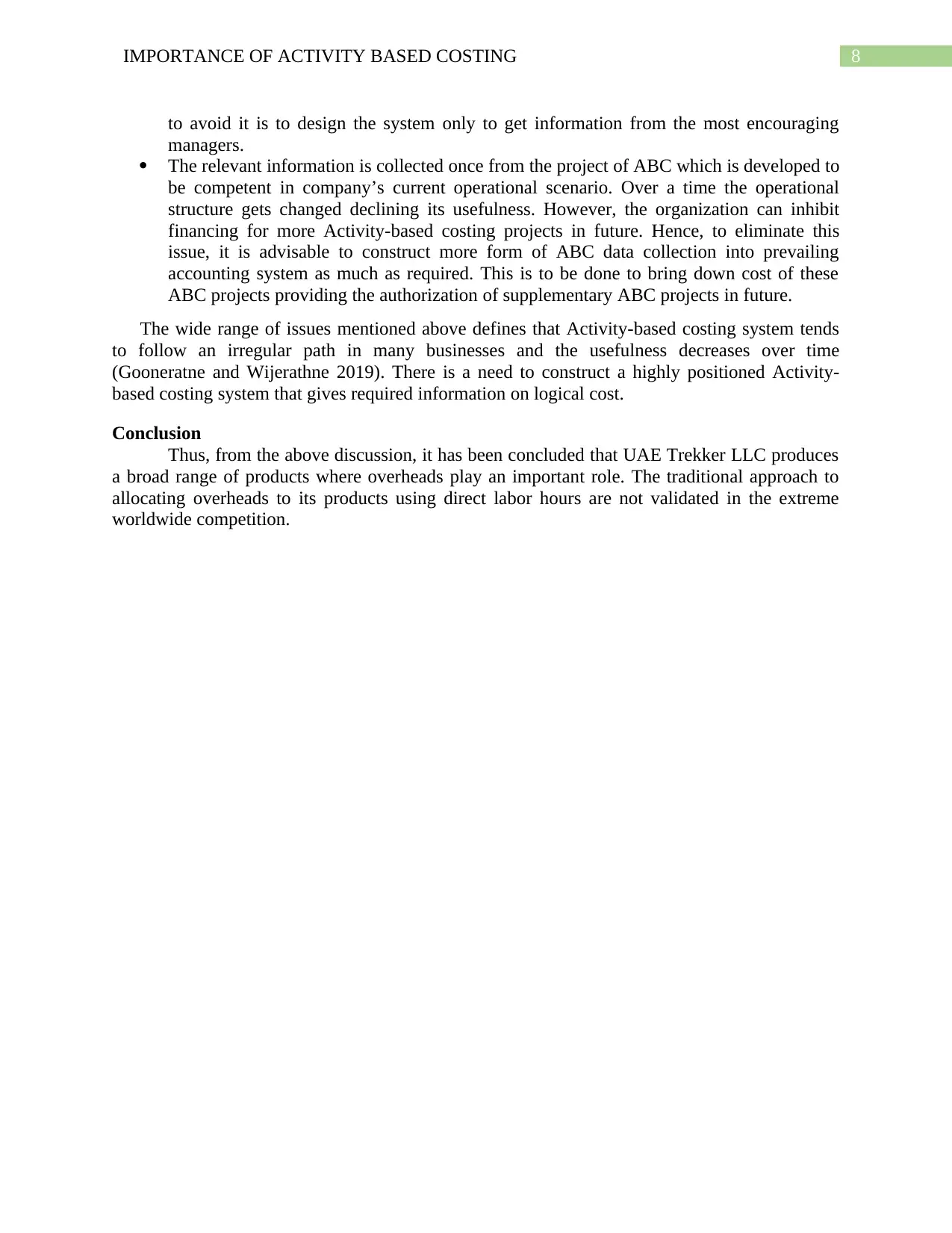
8IMPORTANCE OF ACTIVITY BASED COSTING
to avoid it is to design the system only to get information from the most encouraging
managers.
The relevant information is collected once from the project of ABC which is developed to
be competent in company’s current operational scenario. Over a time the operational
structure gets changed declining its usefulness. However, the organization can inhibit
financing for more Activity-based costing projects in future. Hence, to eliminate this
issue, it is advisable to construct more form of ABC data collection into prevailing
accounting system as much as required. This is to be done to bring down cost of these
ABC projects providing the authorization of supplementary ABC projects in future.
The wide range of issues mentioned above defines that Activity-based costing system tends
to follow an irregular path in many businesses and the usefulness decreases over time
(Gooneratne and Wijerathne 2019). There is a need to construct a highly positioned Activity-
based costing system that gives required information on logical cost.
Conclusion
Thus, from the above discussion, it has been concluded that UAE Trekker LLC produces
a broad range of products where overheads play an important role. The traditional approach to
allocating overheads to its products using direct labor hours are not validated in the extreme
worldwide competition.
to avoid it is to design the system only to get information from the most encouraging
managers.
The relevant information is collected once from the project of ABC which is developed to
be competent in company’s current operational scenario. Over a time the operational
structure gets changed declining its usefulness. However, the organization can inhibit
financing for more Activity-based costing projects in future. Hence, to eliminate this
issue, it is advisable to construct more form of ABC data collection into prevailing
accounting system as much as required. This is to be done to bring down cost of these
ABC projects providing the authorization of supplementary ABC projects in future.
The wide range of issues mentioned above defines that Activity-based costing system tends
to follow an irregular path in many businesses and the usefulness decreases over time
(Gooneratne and Wijerathne 2019). There is a need to construct a highly positioned Activity-
based costing system that gives required information on logical cost.
Conclusion
Thus, from the above discussion, it has been concluded that UAE Trekker LLC produces
a broad range of products where overheads play an important role. The traditional approach to
allocating overheads to its products using direct labor hours are not validated in the extreme
worldwide competition.
⊘ This is a preview!⊘
Do you want full access?
Subscribe today to unlock all pages.

Trusted by 1+ million students worldwide
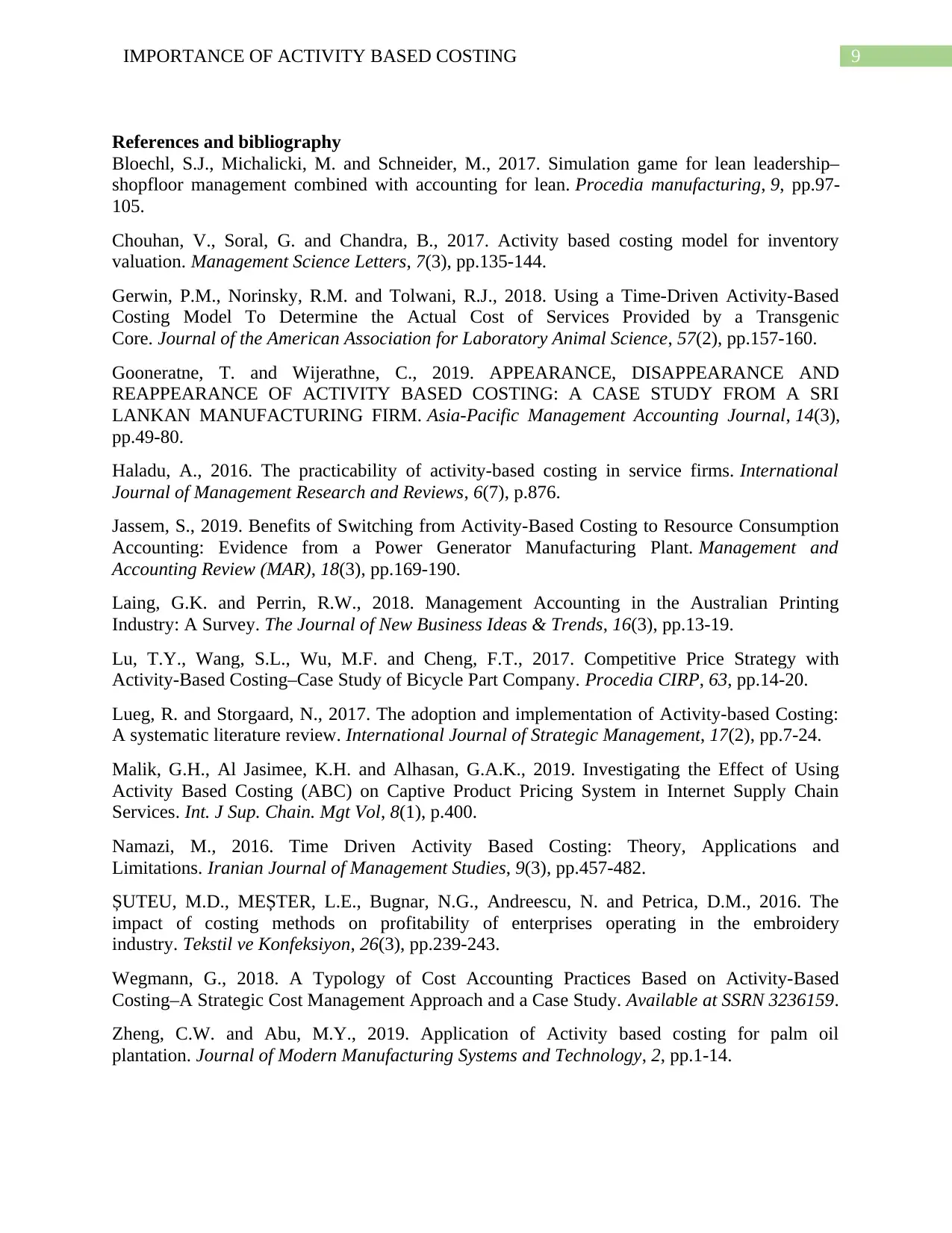
9IMPORTANCE OF ACTIVITY BASED COSTING
References and bibliography
Bloechl, S.J., Michalicki, M. and Schneider, M., 2017. Simulation game for lean leadership–
shopfloor management combined with accounting for lean. Procedia manufacturing, 9, pp.97-
105.
Chouhan, V., Soral, G. and Chandra, B., 2017. Activity based costing model for inventory
valuation. Management Science Letters, 7(3), pp.135-144.
Gerwin, P.M., Norinsky, R.M. and Tolwani, R.J., 2018. Using a Time-Driven Activity-Based
Costing Model To Determine the Actual Cost of Services Provided by a Transgenic
Core. Journal of the American Association for Laboratory Animal Science, 57(2), pp.157-160.
Gooneratne, T. and Wijerathne, C., 2019. APPEARANCE, DISAPPEARANCE AND
REAPPEARANCE OF ACTIVITY BASED COSTING: A CASE STUDY FROM A SRI
LANKAN MANUFACTURING FIRM. Asia-Pacific Management Accounting Journal, 14(3),
pp.49-80.
Haladu, A., 2016. The practicability of activity-based costing in service firms. International
Journal of Management Research and Reviews, 6(7), p.876.
Jassem, S., 2019. Benefits of Switching from Activity-Based Costing to Resource Consumption
Accounting: Evidence from a Power Generator Manufacturing Plant. Management and
Accounting Review (MAR), 18(3), pp.169-190.
Laing, G.K. and Perrin, R.W., 2018. Management Accounting in the Australian Printing
Industry: A Survey. The Journal of New Business Ideas & Trends, 16(3), pp.13-19.
Lu, T.Y., Wang, S.L., Wu, M.F. and Cheng, F.T., 2017. Competitive Price Strategy with
Activity-Based Costing–Case Study of Bicycle Part Company. Procedia CIRP, 63, pp.14-20.
Lueg, R. and Storgaard, N., 2017. The adoption and implementation of Activity-based Costing:
A systematic literature review. International Journal of Strategic Management, 17(2), pp.7-24.
Malik, G.H., Al Jasimee, K.H. and Alhasan, G.A.K., 2019. Investigating the Effect of Using
Activity Based Costing (ABC) on Captive Product Pricing System in Internet Supply Chain
Services. Int. J Sup. Chain. Mgt Vol, 8(1), p.400.
Namazi, M., 2016. Time Driven Activity Based Costing: Theory, Applications and
Limitations. Iranian Journal of Management Studies, 9(3), pp.457-482.
ȘUTEU, M.D., MEȘTER, L.E., Bugnar, N.G., Andreescu, N. and Petrica, D.M., 2016. The
impact of costing methods on profitability of enterprises operating in the embroidery
industry. Tekstil ve Konfeksiyon, 26(3), pp.239-243.
Wegmann, G., 2018. A Typology of Cost Accounting Practices Based on Activity-Based
Costing–A Strategic Cost Management Approach and a Case Study. Available at SSRN 3236159.
Zheng, C.W. and Abu, M.Y., 2019. Application of Activity based costing for palm oil
plantation. Journal of Modern Manufacturing Systems and Technology, 2, pp.1-14.
References and bibliography
Bloechl, S.J., Michalicki, M. and Schneider, M., 2017. Simulation game for lean leadership–
shopfloor management combined with accounting for lean. Procedia manufacturing, 9, pp.97-
105.
Chouhan, V., Soral, G. and Chandra, B., 2017. Activity based costing model for inventory
valuation. Management Science Letters, 7(3), pp.135-144.
Gerwin, P.M., Norinsky, R.M. and Tolwani, R.J., 2018. Using a Time-Driven Activity-Based
Costing Model To Determine the Actual Cost of Services Provided by a Transgenic
Core. Journal of the American Association for Laboratory Animal Science, 57(2), pp.157-160.
Gooneratne, T. and Wijerathne, C., 2019. APPEARANCE, DISAPPEARANCE AND
REAPPEARANCE OF ACTIVITY BASED COSTING: A CASE STUDY FROM A SRI
LANKAN MANUFACTURING FIRM. Asia-Pacific Management Accounting Journal, 14(3),
pp.49-80.
Haladu, A., 2016. The practicability of activity-based costing in service firms. International
Journal of Management Research and Reviews, 6(7), p.876.
Jassem, S., 2019. Benefits of Switching from Activity-Based Costing to Resource Consumption
Accounting: Evidence from a Power Generator Manufacturing Plant. Management and
Accounting Review (MAR), 18(3), pp.169-190.
Laing, G.K. and Perrin, R.W., 2018. Management Accounting in the Australian Printing
Industry: A Survey. The Journal of New Business Ideas & Trends, 16(3), pp.13-19.
Lu, T.Y., Wang, S.L., Wu, M.F. and Cheng, F.T., 2017. Competitive Price Strategy with
Activity-Based Costing–Case Study of Bicycle Part Company. Procedia CIRP, 63, pp.14-20.
Lueg, R. and Storgaard, N., 2017. The adoption and implementation of Activity-based Costing:
A systematic literature review. International Journal of Strategic Management, 17(2), pp.7-24.
Malik, G.H., Al Jasimee, K.H. and Alhasan, G.A.K., 2019. Investigating the Effect of Using
Activity Based Costing (ABC) on Captive Product Pricing System in Internet Supply Chain
Services. Int. J Sup. Chain. Mgt Vol, 8(1), p.400.
Namazi, M., 2016. Time Driven Activity Based Costing: Theory, Applications and
Limitations. Iranian Journal of Management Studies, 9(3), pp.457-482.
ȘUTEU, M.D., MEȘTER, L.E., Bugnar, N.G., Andreescu, N. and Petrica, D.M., 2016. The
impact of costing methods on profitability of enterprises operating in the embroidery
industry. Tekstil ve Konfeksiyon, 26(3), pp.239-243.
Wegmann, G., 2018. A Typology of Cost Accounting Practices Based on Activity-Based
Costing–A Strategic Cost Management Approach and a Case Study. Available at SSRN 3236159.
Zheng, C.W. and Abu, M.Y., 2019. Application of Activity based costing for palm oil
plantation. Journal of Modern Manufacturing Systems and Technology, 2, pp.1-14.
Paraphrase This Document
Need a fresh take? Get an instant paraphrase of this document with our AI Paraphraser
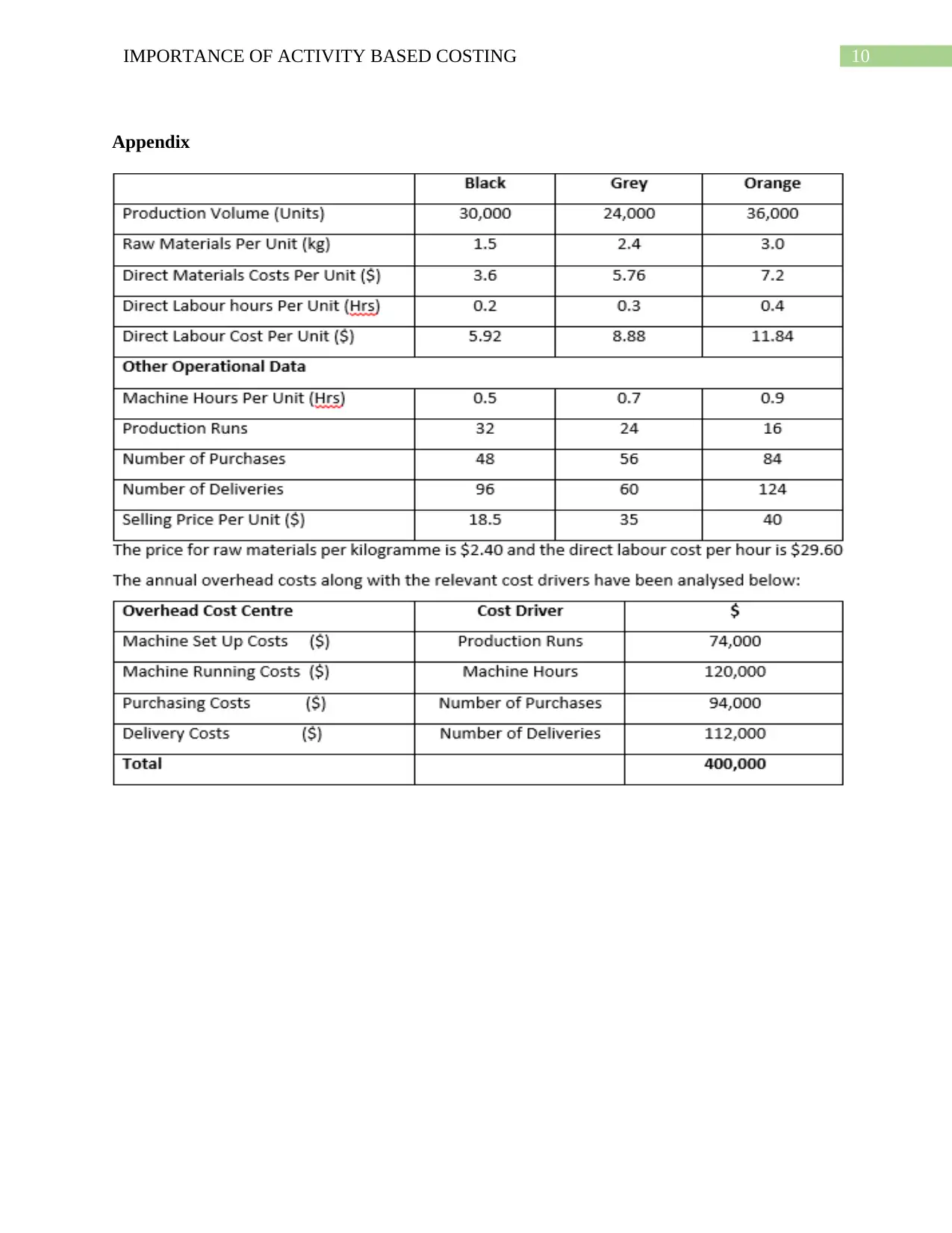
10IMPORTANCE OF ACTIVITY BASED COSTING
Appendix
Appendix
1 out of 11
Related Documents
Your All-in-One AI-Powered Toolkit for Academic Success.
+13062052269
info@desklib.com
Available 24*7 on WhatsApp / Email
![[object Object]](/_next/static/media/star-bottom.7253800d.svg)
Unlock your academic potential
Copyright © 2020–2025 A2Z Services. All Rights Reserved. Developed and managed by ZUCOL.




